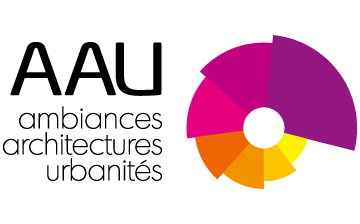A propos du laboratoire
Depuis sa création en 1998, le Laboratoire AAU se développe de manière fortement interdisciplinaire, tant dans sa composition (architectes, sociologues, informaticiens, anthropologues, urbanistes, géographes, physiciens, historiens, philosophes), que par les problématiques et enjeux auxquels il répond (architecture, environnement, urbanisme), et par les outils qu'il conçoit et me en œuvre (méthodologies d'enquêtes in situ, modélisation et simulation des phénomènes d'ambiances, réalité virtuelle, etc.)
About the AAU Laboratory
Ever since its creation in 1998, the AAU Laboratory has developed itself in a cross-cutting way, both in its composition (architects, sociologists, computer scientists, anthropologists, urban planners, geographers, physicists, historians, philosophers), in the issues it addresses (architecture, environment, urbanism), and in the tools designed and implemented (in situ surveys, modelling and simulation of factors of ambiance, virtual reality, etc.)
FR
L’UMR Ambiances, Architectures, Urbanités réunit deux équipes implantées sur deux sites : le Centre de Recherche Nantais Architectures Urbanités (CRENAU) situé conjointement à l’ENSAN et à l’ECN ; et le Centre de Recherche sur l’Espace Sonore et l’environnement urbain (CRESSON) situé à l’ENSAG. Le laboratoire compte environ 150 membres répartis dans les deux équipes, dont environ 1/3 de doctorants. Les chercheurs et enseignants-chercheurs appartiennent à différentes écoles d’architecture (l’ENSA Grenoble et l’ENSA Nantes mais aussi l’ENSA Lyon et l’ENSA Paris-la-Villette), au CNRS (rattachement principal SHS, section 39 « Espaces, territoires et sociétés »), à Centrale Nantes et à d’autres établissements par le biais de conventions.
EN
The Ambiances, Architectures, Urbanités research unit brings together two teams on two different sites: the Urban Architecture Nantes Research Centre (CRENAU), located both at ENSA Nantes and Centrale Nantes, and the Research Centre on Acoustic Space and Urban Environment (CRESSON) at ENSA Grenoble. The Laboratory consists of about 125 members over the two sites, among which about 1/3 are PhD students. The researchers and professors-researchers belong to different schools of architecture (ENSA Grenoble, ENSA Nantes, ENSA Lyon and ENSA Paris-la-Villette), to CNRS, to Centrale Nantes, and to other institutions via agreements.
FR
Depuis sa création en 1998, le laboratoire se développe de manière fortement interdisciplinaire, tant par sa composition (architectes, sociologues, informaticiens, anthropologues, urbanistes, géographes, physiciens, historiens, philosophes), que par les problématiques et enjeux auxquels il répond (architecture, environnement, ville), et par les outils qu’il conçoit et met en oeuvre (méthodologies d’enquêtes in situ, modélisation et simulation des phénomènes d’ambiances, réalité virtuelle, etc.).
AAU est à l’origine du Réseau International Ambiances, réseau scientifique thématique du Ministère de la Culture (https://www.ambiances.net/), d’un Groupement de Recherche International du CNRS (GDRI « Ambiances en traduction » 2014/2017), de la revue scientifique « Ambiances – Revue internationale sur l’environnement sensible, l’architecture et l’espace urbain » publiée sur le portail OpenEdition (https://ambiances.revues.org/), du site Cartophonies qui permet d’explorer l’expérience sonore contemporaine (https://www.cartophonies.fr/), ainsi que de plusieurs carnets de recherche en ligne. Le laboratoire bénéficie d’un important réseau de partenaires sur les deux sites des équipes de Grenoble et de Nantes, ainsi qu’au niveau national et international.
Direction
- Directeur du laboratoire AAU : Rachel Thomas
- Directrice-adjointe, directrice de l’équipe CRENAU (Nantes) : Myriam Servières
- Directeur-adjoint, directeur de l’équipe CRESSON (Grenoble) : Nicolas Tixier
Composition du Conseil de laboratoire
- Membres élus pour le collège Recherche et enseignement : Céline Bonicco-Donato, Laurent Devisme, Céline Drozd, Rainer Kazig, Théa Manola, Elise Roy.
- Membres élus pour le collège Appui et soutien à la recherche : Laurent Charrieau, Cédric Pichat.
- Membres élus pour le collège Doctorants : Thibault Rabain, George Abou Mrad (2022-2023).
- Membres nommés : Thomas Leduc, Jean-Paul Thibaud (2022) remplacé par Perrine Poupin (2023- …).
- Le directeur et les directeurs-adjoints.
EN
Ever since its creation in 1998, the AAU Laboratory has developed itself in a cross-cutting way, both in its composition (architects, sociologists, computer scientists, anthropologists, urban planners, geographers, physicists, historians, philosophers), in the issues it addresses (architecture, environment, urbanism), and in the tools designed and implemented (in situ surveys, modelling and simulation of factors of ambiance, virtual reality, etc.)
The AAU Laboratory founded the International Ambiances Network (https://www.ambiances.net/), which is a thematic research network upheld by the French Ministry of Culture and Communication, as well as one of the CNRS’ International Research Networks (GDRI “Ambiances in Translation”). It also founded scientific journal “Ambiances – International journal of sensory environment, architecture and urban space” published on the OpenEdition portal (http://ambiances.revues.org), the Cartophonie website, which allows the user to explore contemporary soundscapes, and numerous other research logs (http://www.cartophonies.fr/). The Laboratory enjoys an important network of partners on both sites of Grenoble and Nantes, as well as nationally and internationally.
Board
Director of the AAU Laboratory: Rachel Thomas
Director of the CRENAU research team: Myriam Servières
Director of the CRESSON research team: Nicolas Tixier
Composition of the Laboratory Board
- Elected members for the Research and Training college:
Céline Bonicco-Donato, Laurent Devisme, Céline Drozd, Rainer Kazig, Théa Manola, Elise Roy - Elected members for the Support and Research Support college: Laurent Charrieau, Cédric Pichat.
- Elected members for the PhD Students college: Thibault Rabain, George Abou Mrad (2022-2023).
- Nominated members: Thomas Leduc, Jean-Paul Thibaud (2022), replaced by Perrine Poupin (2023 – … )
- Director and co-directors.
